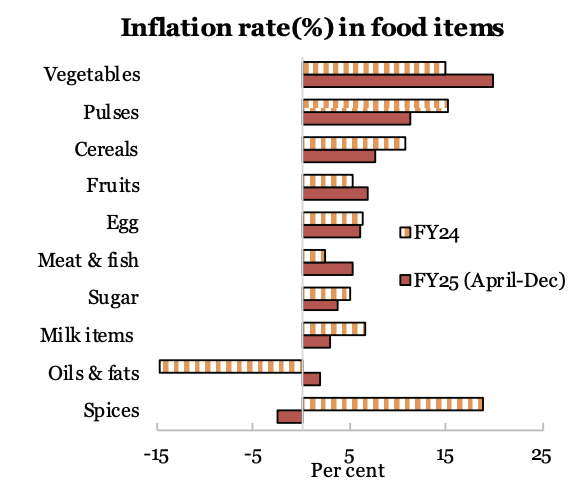Introduction
- Global inflation: Declined to 5.7% in 2024 from its peak of 8.7% in 2022 (IMF).
- Core inflation: Reached its lowest point in a decade.
Domestic Inflation
- India's Retail inflation: Reduced from 5.4% in FY24 to 4.9% in FY25 (April-December 2024).
- Reason for decline in retail inflation: Decrease in core inflation by 0.9 percentage points between FY24 and FY25, largely driven by core services inflation and decrease in fuel price inflation.
- Decline in core inflation was largely driven by core services inflation, which was lower than core goods inflation.
Food Inflation

- Over the past two years, India's food inflation rate has remained firm.
- Extreme weather conditions (cyclones, heavy rains, hailstorms, droughts, heatwaves etc.) impacts vegetable production (mainly onion and tomato), and supply chains, thereby affecting retail prices.
- Consumer Food Price Index (CFPI) has increased from 7.5% in FY24 to 8.4% in FY25, primarily driven by a few food items particularly vegetables and pulses.
- By excluding Tomato, Onion and Potato (TOP) - most price-sensitive vegetables- from CPI basket, average food inflation rate in FY25 was 6.5%.
- Administrative measures to control food inflation
- Cereals: Stock limits on wheat; Offloaded wheat and rice from central pool under Open Market Sale Scheme; Sale of wheat flour and rice under Bharat brand.
- Pulses: Sale of chana dal, moong dal and masur dal under Bharat brand; Imposition of Stock limits on tur and desi chana; Allowed duty-free import of desi chana, tur, urad, masur and yellow peas.
- Vegetables: Buffer Stock of Onion (4.7 lakh MT of rabi onion procured under Price Stabilisation Fund); Subsidised sale of Onion and Tomato.
Outlook
- Consumer Price Inflation (CPI): RBI and IMF projected India's CPI will gradually align with the target in FY26.
- Inflation Rate: IMF has projected an inflation rate of 4.4% in FY25 and 4.1% in FY26 for India.
- Headline inflation: RBI expects headline inflation to be 4.2% in FY26, if there is normal monsoon and no further external or policy shocks.
Ways to ensure long-term price stability
- Developing climate-resilient crop varieties, thus enhancing yield and reducing crop damage.
- Farmers should receive training on best practices, use of high-yield and disease-resistant seed varieties to improve agricultural practices in major growing regions for pulses, tomatoes, and onions.
- Implementing robust data collection and analysis systems in various tiers of government to monitor prices, stocks, storage and processing facilities, and make informed policy decisions.
One Line SummaryIndia's inflation remains stable but faces risks from food price volatility, fuel fluctuations, and supply chain disruptions, requiring strong monetary policy and supply-side interventions |
Relevance for UPSC
|


